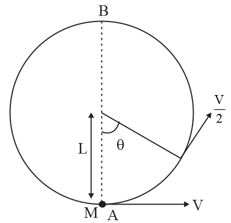Q. Consider the earth as a uniform sphere of mass $M$ and radius $R$ . Imagine a straight smooth tunnel made through the earth which connects any two points on its surface. Determine the time that a particle would take to go from one end to the other through the tunnel.
Solution:
Suppose at some instant the particle is at radial distance r from centre of earth O. Since, the particle is constrained to move along the tunnel, we define its position as distance x from C. Hence, equation of motion of the particle is,
max = Fx
The gravitational force on mass m at distance r is,

$ \text{F} = \frac{\text{GMmr}}{\text{R}^{3}}$ (towards O)
Therefore, $\quad \mathrm{F}_x=-\mathrm{F} \sin \theta=-\frac{\mathrm{GMmr}}{\mathrm{R}^3}\left(\frac{x}{\mathrm{r}}\right)$
$ = - \frac{\text{GMmr}}{\text{R}^{3}} \cdot x$
Since, Fx ∝ - x, motion is simple harmonic in nature. Further,
$ \text{m} a_{x} = - \frac{\text{GMm}}{\text{R}^{3}} \cdot x \text{or} a_{x} = - \frac{\text{GM}}{\text{R}^{3}} \cdot x$
∴ Time period of oscillation is,
$\mathrm{T}=2 \pi \sqrt{\left|\frac{x}{a_x}\right|}=2 \pi \sqrt{\frac{\mathrm{R}^3}{\mathrm{GM}}}$
The time taken by particle to go from one end to the other is $\frac{T}{2} .$
$\mathrm{t}=\frac{\mathrm{T}}{2}=\pi \sqrt{\frac{\mathrm{R}^3}{\mathrm{GM}}}$
Questions from NTA Abhyas 2020
2. The velocity displacement graph of a particle moving along a straight line is -

The most suitable acceleration-displacement graph will be
Motion in a Straight Line
3. A drum of radius $R$ and mass $M$ rolls down without slipping along an inclined plane of angle $\theta $ . The frictional force
System of Particles and Rotational Motion
Questions from Oscillations
2. Infinite springs with force constants $k,\, 2k,\, 4k$ and $8k...$ respectively are connected in series. The effective force constant of the spring will be
J & K CET 2004
3. Which one of the following is a simple harmonic motion?
NTA Abhyas 2020
Physics Most Viewed Questions
1. If $E$ and $G$ respectively denote energy and gravitational constant, then $\frac{ E }{ G }$ has the dimensions of:
NEET 2021
Physical World, Units and Measurements
2. The de Broglie wavelength of an electron moving with kinetic energy of $144 \,eV$ is nearly
NEET 2020
Dual Nature of Radiation and Matter
3. A car starts from rest and accelerates at $5\, m / s ^{2}$ At $t=4\, s$, a ball is dropped out of a window by a person sitting in the car. What is the velocity and acceleration of the ball at $t =6\, s$ ? (Take $\left. g =10\, m / s ^{2}\right)$
NEET 2021
Motion in a Straight Line
Latest Updates
- JEE Main 2023 February 25th Shift 1 Morning
- JEE Main 2023 February 25th Shift 2 Evening
- JEE Main 2023 January 31st Shift 1 Morning
- JEE Main 2023 January 31st Shift 2 Evening
- JEE Main 2023 January 30th Shift 1 Morning
- JEE Main 2023 January 30th Shift 2 Evening
- JEE Main 2023 January 25th Shift 1 Morning
- JEE Main 2023 January 25th Shift 2 Evening
- JEE Main 2023 January 24th Shift 1 Morning
- JEE Main 2023 January 24th Shift 2 Evening
- JEE Main 2023 February 1st Shift 1 Morning
- JEE Main 2023 February 1st Shift 2 Evening
- JEE Main 2022 July 25th Shift 1 Morning
- JEE Main 2022 July 25th Shift 2 Evening
- JEE Main 2022 July 26th Shift 1 Morning
- JEE Main 2022 July 28th Shift 1 Morning
- JEE Advanced 2022 Paper 2
- JEE Advanced 2022 Paper 1
- JEE Advanced 2021 Paper 2
- JEE Advanced 2021 Paper 1
- JEE Advanced 2020 Paper 2
- JEE Advanced 2020 Paper 1
- NEET 2022 Physics Answer Key
- NEET 2022 Chemistry Answer Key
- NEET 2022 Botany Biology Answer Key
- NEET 2022 Zoology Biology Answer Key
- NEET Rank Predictor 2023
